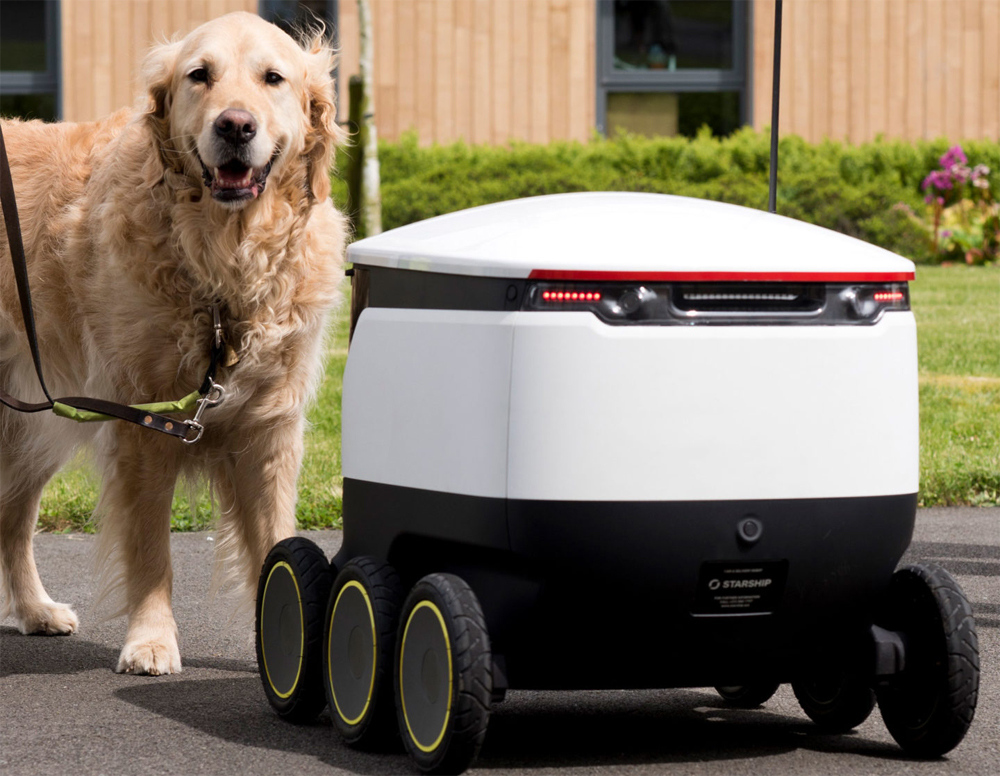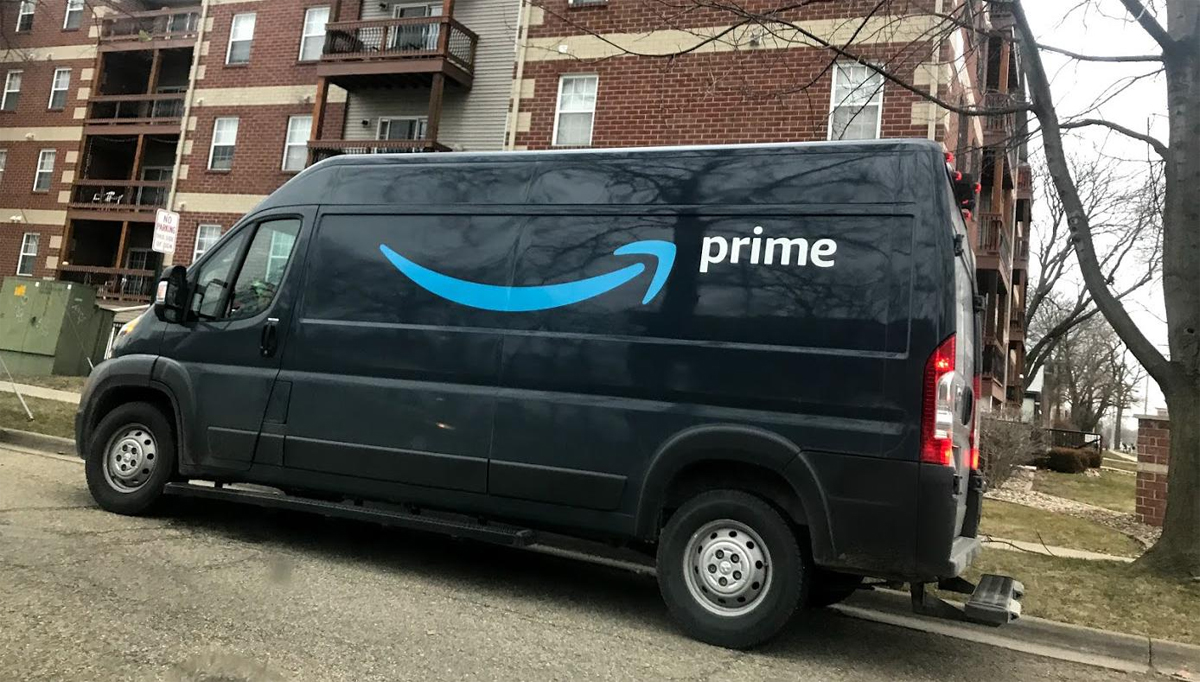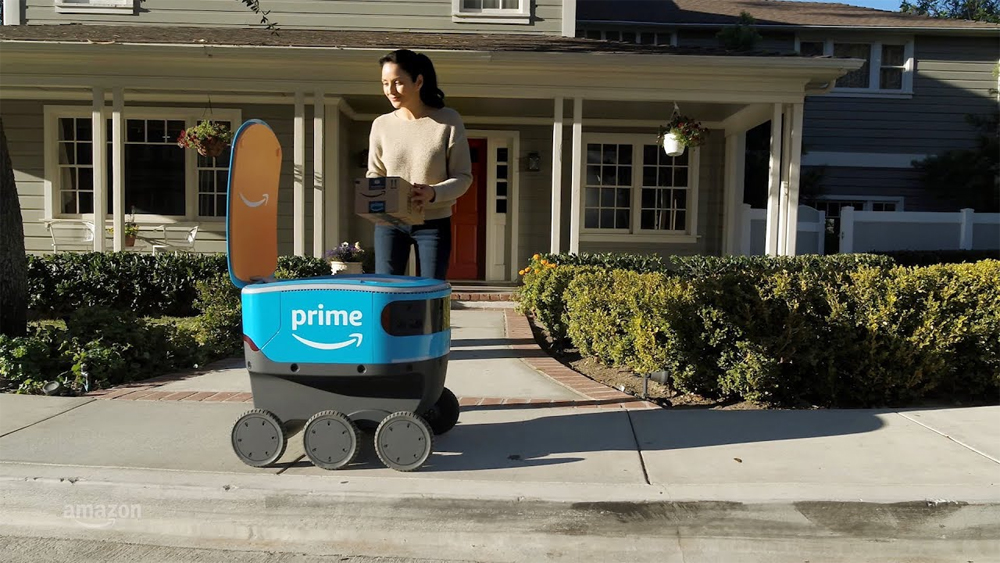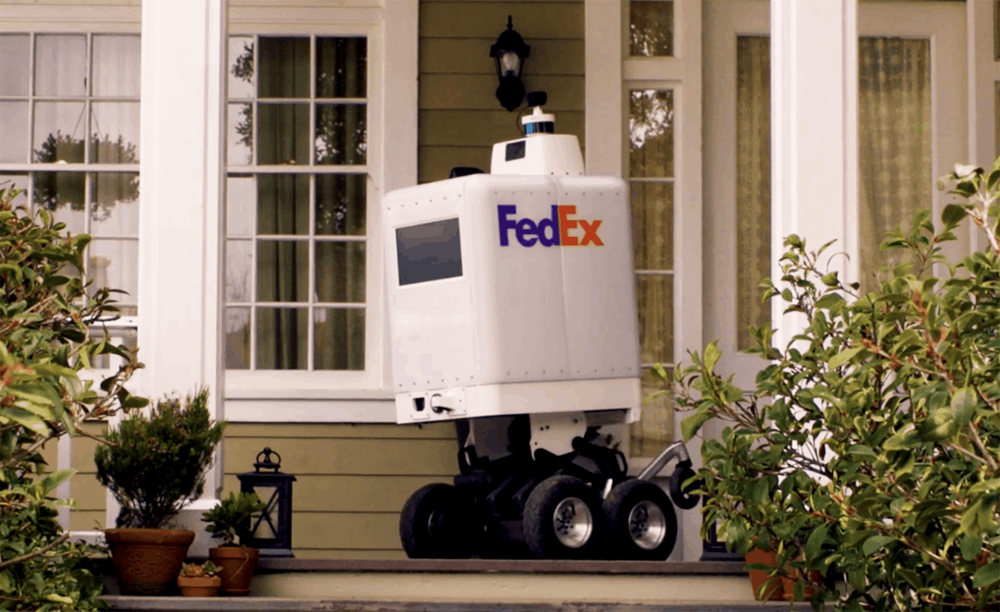What the first Amazon and FedEx courier robots look like

In the near future, purchases from online stores will not be delivered to us by people on automobiles, but by flocks of robots traveling along the sidewalks. Several promising projects are working in this direction at once. Starship Technologies from Estonia is already using small robots, couriers in hundreds of cities to deliver hot products from pizzerias and restaurants. Marble, a San Francisco startup, learned to deliver falafel with a similar method. Kiwi robots bring food to UC Berkeley students in California, and sometimes catch fire .
And recently, Amazon announced the start of field trials of its own robot courier - Scout. A six-wheel autonomous droid will travel on the sidewalks and deliver parcels to Amazon Prime subscribers in major US cities. For a start, the machine will start working in the quiet Snohomish district in Washington. From Monday to Friday, during those hours of the day when there are fewer pedestrians on the streets.

At Scout, at first there will always be a companion person checking that the bot "safely and efficiently travels around people, pets and everything else in its path." Prime users with the help of a robot will have to see an even more significant reduction in delivery time. Amazon promises that most orders will be processed and come to the buyer on the same day.
The company has been experimenting with ways to make delivery faster and cheaper for more than ten years. A particularly big problem in recent years has become the so-called “last mile” - delivery from warehouses directly to buyers' houses. Here, Amazon is now forced to rely on the state. US mail, USPS. Only that one has the resources (and the desire) to go every day along the same routes, to tens of millions of homes daily. The problem is that some authorities in America are convinced that such cooperation with Amazon for the USPS is ultimately unprofitable, and they want to ban the state. mail to accept parcels from a private company. One of them is Trump, who last year virtually announced Amazon to vendetta .
If the state. there will be no mail - the entire structure built by the company threatens to collapse. To insure yourself, you need to find your own options. Therefore, Amazon is so actively developing delivery by drones, patenting towers in which they could “nest”, and trying to arrange for people to work as couriers on their way home or to work.
In 2018, the company launched the Delivery Service Partners program . Entrepreneurs registered in it can hire drivers and get up to 40 trucks from Amazon in order to deliver parcels from warehouses to homes. The company wants to hire at least 1000 such "partners", each of which will receive from $ 75 to $ 300 thousand per year. Not so bad for a small business owner who is also given good credit for starting.

')
But even a few thousand private entrepreneurs will not cope with the necessary volume of orders. Plus, what if one of them "falls off"? A few days without parcels for the town residents? Amazon can't risk that much.
Robots must eliminate these shortcomings. They are easily replaced, do not occupy space for parking, do not confuse parcels and do not require regular salary increases.
Argument "against"
Amazon came quite late to the idea of ground-based robots, couriers, and its path in this area promises to be difficult. Such robots are like unmanned vehicles, only with a large number of parameters that you need to worry about. Highways and highways are more or less regulated, they have a structure and a set of rules to be followed. Sidewalks are more intuitive. There is no red traffic light or specific lanes that need to be moved. The delivery robot should be able to evaluate a lot more situations, and somehow navigate in all this chaos. Considering that the door can open in front of him, monitor the animals and their leads, check whether there is a pool or a broken tile in front of him, understand when he needs to cross the road, and how best to do it. Even in the present age of unmanned vehicles, teaching AI to respond to all these situations will be extremely difficult.
Scout is still using machine vision technology, more than a dozen cameras and a lidar to help avoid obstacles. So far, only six cars will be released onto the roads - to collect information and test the operation of the systems.

Given how many companies go in the direction of robots, couriers, you might think that the future is definitely theirs. Especially when you have limitless Amazon finances. But Brian Gerki, the head of Open Robotics supporting open hardware and software in robotics, has some doubts:
It is not yet clear that this market exists. Maybe it turns out that in such robots there is no economic sense. It is difficult to imagine that they were better in moving along the sidewalks than the person for whom they were created. A non-standard staircase, an unexpected obstacle, a careless passer-by - and your package will never be delivered.
The only thing that the messenger robot has so far is an advantage - he never gets tired. The rest so far - solid cons. He will not be able to open the gate or door, will not be able to clarify the way. And, if the story of the electric scooters showed something, people would not give up their pavement so easily. When they see a smug robot occupying their rightful place, some will want to show him who's boss. Many Scouts will be broken or stolen, this is guaranteed, nothing can be done about it. A system that could provide a small, expensive device with complete security does not yet exist.
The argument is "for"
For many, the interaction with the Scout will be even more pleasant than working with a human courier. From the point of view of the Amazon client, there is nothing difficult here. You buy a product, you receive a PIN-code on your smartphone (and e-mail), after a few hours you receive a signal, open the door, see the robot, enter the code, open the slot and pick up your package. So far, the disadvantage here is that if you are not at home, there is no one to enter the PIN code and the package will not be delivered. But this is easily solved. It is enough to give the person the opportunity to choose the option to leave the package at the door. Then the delivery of the robot will be little different from the delivery of people, plus the robot, with its cameras and GPS, has less chance to make a mistake by the door.

In order not to annoy pedestrians, Scout will move at an average walking speed. Perhaps even adjusting if the stream starts moving more slowly or faster. Bob Doyle, vice president of Robotic Industries, says that this will allow the machine to quickly become accepted among people, "to join their environment." He also compliments Scout's design:
In my opinion, a good balance is achieved. He looks friendly enough for people not to kick him, but not so friendly that the children run up and hug him and prevent him from doing his job.
The main thing - a new technology opens up a large field for potential profits. And the one who first captures this market, as is usually the case with new technologies, will be a big plus. Parcel delivery is still a highly inefficient process, with many stages, at each of which an error or hitch can occur. Full automation can solve a lot of problems, and save large companies a lot of money if everything works out.

Not only Amazon understands this. Just a couple of days after the announcement of the start of the work of Skat, his bot courier was presented to him by FedEx in competition. Her device has even managed to participate in the show with Jimmy Fallon, demonstrating his ability to ride on sand and gravel. This SameDay Bot is promised to carry parcels for Pizza Hut, Walmart, Target, Lowe's, Walgreens and several other large retailers. Responsible for its development is the inventor Dean Kamen, the author of Segway and the iBOT all-terrain wheelchair. FedEx and Kamen are expected to start work in July, when the advice of selected cities will approve its use.

The problem with the perception of the bot among pedestrians, they decided in their own way. He has a little more, almost the height of a man, and with a screen in the center in which the robot will communicate its intentions. It is much more difficult to negatively relate to the typewriter, which at the meeting tells you "Hello!". And for the same children, he can write "Please don't touch me J". The same screen at the back shows when the robot is about to turn or stop. Developers of unmanned cars experienced similar technology before. According to them, this reduces the number of accidents and overall misunderstandings between man and machine.

For Amazon and FedEx, the first months of testing robots should allow companies to decide whether to supplement normal human couriers, or the technology is still too raw. Few people doubt that in the end, maybe in five or ten years, similar machines will be successfully used for delivery - perhaps in some particular niche. For clients of companies, however, the difference is unlikely to be noticeable. Parcels will simply still appear in front of their door. All this work is hundreds of millions of dollars with the most advanced technology - in order for customers not to feel the difference.
Source: https://habr.com/ru/post/444824/
All Articles